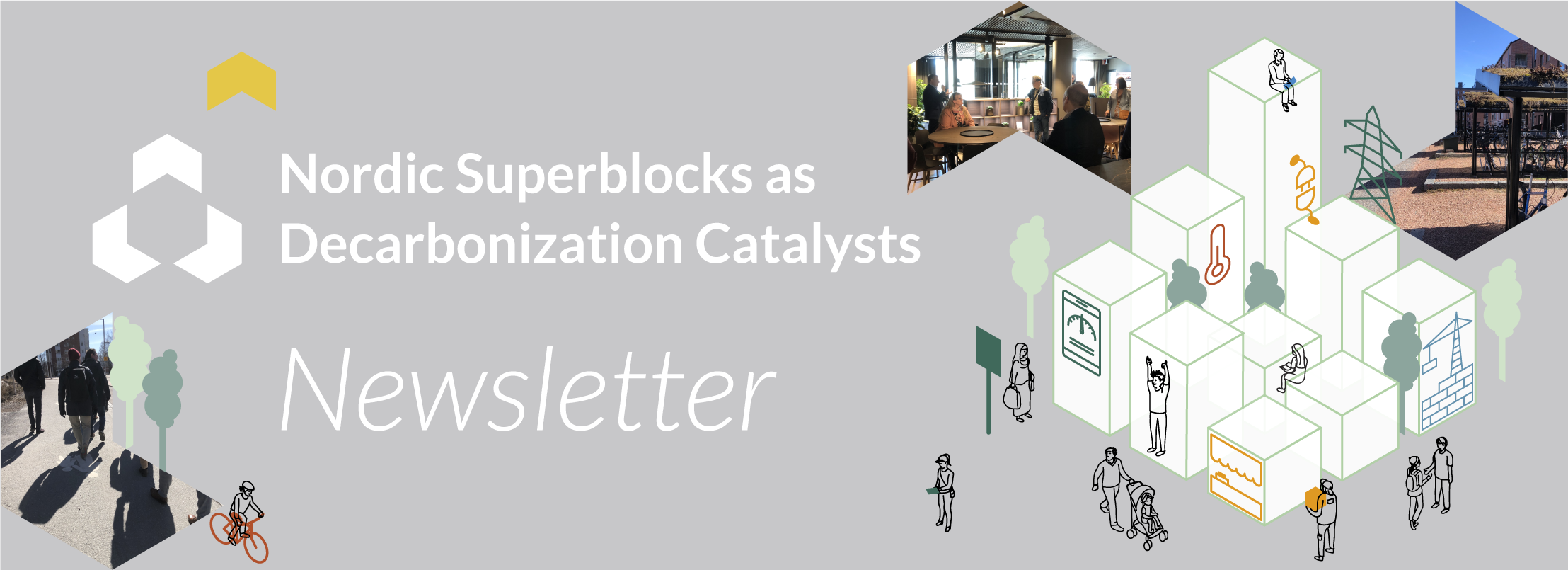11 June 2024
How can cities engage citizens and other stakeholders in developing the city? Find out in the first issue of the NSDC newsletter
For a printable pdf version click here: NSDC newsletter 1
Improving sustainability and livability together at the WALCC Forum
This year’s Forum of the World Alliance for Low Carbon Cities will be held in Porvoo 17.-18.9.2024. Among the topics discussed at the Forum will be urban planning and green building, addressed through two sessions led by partners of the Nordic Superblocks as Decarbonization Catalysts initiative (NSDC). A session titled Shaping Cities for Sustainability and Livability will present findings from our discussions with city representatives on how the energy transition, public-private collaborative planning, and new service concepts influence city planning with case presentations from cities such as Tampere, Malmö, and Milan. Another session, Citizen Engagement through Digitalization, will share best practices on how the use of digital tools can increase the possibilities for citizens to co-create the living experience together with public and private partners throughout the lifecycle of a property.
UPDATE: For a report on the Forum see here
Ensuring continuous stakeholder collaboration during the property life cycle
The NSDC initiative has engaged in extensive discussions with city developers, companies, and researchers to better understand how collaboration should be carried out throughout the lifecycle of a property. The major risks of discontinuity occur when the responsibilities are transferred: from planning to construction, from construction to sales, and from sales to operation. During these discontinuities, attention should be paid to ensuring the goals of sustainability and livability are fulfilled.
Our interactions have confirmed the importance of handling various forms of discontinuity. A new dimension here worth attention is the issue of ownership. Two types of ownership have been identified: institutional and emotional ownership. Institutional ownership refers to the decision rights and is normally transferred from the landowner to the construction company, and then, over time, to different property owners. Emotional ownership refers to the collective engagement around the property to enhance quality of life for its residents. Here, we have found that examples such as Kotikatu365 and Jaso have been able to significantly improve the sense of collective ownership around the common built environment. New types of services have been developed and cities and municipalities are also proactively participating in developing this area. Here, as in any project, the process is dependent on key persons and their commitment. As the responsibility for the development of the property is gradually transferred from planners and builders to investors and residents, the concept of the superblock introduces a means to engage the various participants in fruitful and more comprehensive collaboration to avoid discontinuities.
Co-creating the living experience – starting from the residents
When integrating multiple requirements on our living environment: affordability, sustainability, livability, and adaptability, we must more actively share information to increase the interest of respective parties to engage. Traditionally, such information sharing has been concentrated to the planning phase, when the city planners, together with architects and construction companies, have defined what type of living experience will be created. The agreed-upon design has then been marketed and sold/rented on a first-come, first-served basis. To what extent the residents will, over time, be collectively engaged is then up to active individuals among the residents who can mobilize others to team up around a common engagement to make the living experience as attractive as possible for most of the residents. The NSDC initiative looks for a new way to engage citizens in co-creating the living experience throughout the lifecycle of the building, starting with the early planning phase. Elina Alatalo, of Tampere University, expounds on citizen engagement and participation in planning on our blog.
latest NSDC blog
Local area energy plans – Insights from Granlund
Cities invest in urban planning to achieve their carbon neutrality goals. The superblock is built on the principles of local energy plans supporting the urban planning for carbon neutrality. A carbon-neutral local area energy plan is the result of working together towards mutual goals. Utilizing waste energy flows, low-temperature heat networks, and demand response are key factors in energy and cost-efficient urban planning of the future. Learn more about this in the blog post by Oskari Fagerström, Project Manager at Granlund
NSDC Partner News
Tietoevry explores energy storage and balancing solutions with EnergyOpti
Evolving energy markets require new solutions to ensure the adequacy and distribution of electricity. The collaboration between NSC EnergyOpti Oy and Tietoevry will enhance the availability of electricity and facilitate the development of new renewable electricity generation capacity. This is crucial, especially as the share of intermittent renewable electricity generation grows. Additionally, grid-connected batteries will enable companies utilizing them to actively participate in the electricity market. For more information on these new possibilities, please read here.
NSDC Partner News
KONE is tackling rush hours in stations with digital twin
Using the digital twin concept KONE can ensure not just that the elevator is the right one for the building, but that there is the best possible optimization of the flow of people and materials in that specific environment. The innovative concept has first been piloted at Helsinki metro station. Utilizing real-time and historical people flow sensor data, the digital twin project combines elevator and escalator status with train information, allowing both a real-time view and forecasts of future traffic scenarios. Discover how KONE is leveraging AWS’ technology to help their customers understand the real-time People Flow insights, improve end-user experience, proactively address future needs, and increase flexibility for changes in capacity needs.
